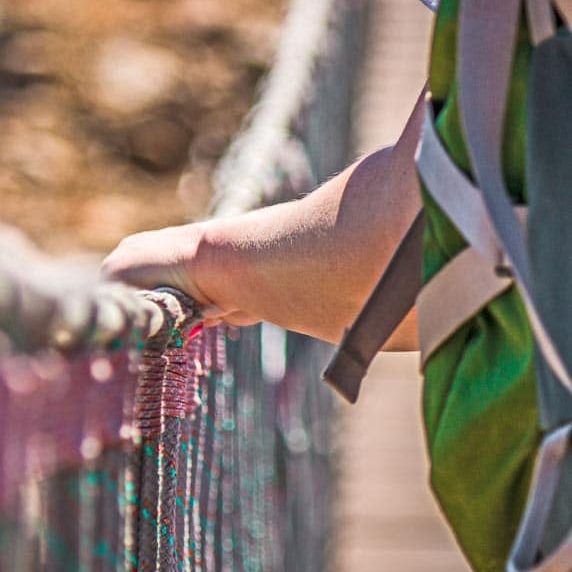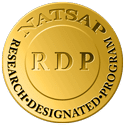
From Struggling to Succeeding: The Transformative Power of Teen ADHD Treatment
For teens with ADHD, finding the right treatment can be a challenge. But with wilderness therapy, you can give your child the support they need to overcome their challenges and achieve success. This innovative approach combines nature and ADHD treatment to create a truly transformative experience.
Take our ADHD test for teens and see if a wilderness therapy program is right for your family.
Teen ADHD can make life difficult for adolescents, impacting their academic performance, relationships, and overall well-being. As a concerned parent, it's essential to understand the disorder and the available treatment options to help your child overcome their symptoms and reach their full potential.
In this piece, we identify the hallmark signs and symptoms of ADHD in teens, explore the various types of ADHD, uncover its causes, examine the impacts it can have, and outline effective treatment options for teens and their families.
Types of ADHD in Teens
ADHD can be a complex disorder to navigate, especially in teenagers who are already facing numerous challenges as they navigate the complexities of adolescence. Understanding the signs of ADHD in teens is critical for parents as early recognition and treatment can make a significant difference in a teen's life. In this section, we'll discuss the different types of ADHD, and take a closer look at the most common symptoms of ADHD in teens.
ADHD Combined Type
Attention-Deficit/Hyperactivity Disorder (ADHD) Combined type, is a subtype of ADHD that affects both inattention and hyperactivity/impulsivity. Teens with this subtype of ADHD have symptoms from both of the other subtypes and may show any of the signs listed below.
Hyperactive-Impulsive ADHD
Attention-Deficit/Hyperactivity Disorder (ADHD) Predominantly Hyperactive-Impulsive type, is a subtype of ADHD that primarily affects teens' impulsivity and hyperactivity. Teens with this subtype of ADHD have a hard time sitting still and controlling their impulsive behaviors.
Some of the common signs and symptoms of hyperactive-impulsive ADHD in teens include:
- Fidgeting, squirming, and excessive physical activity
- Difficulty staying seated or remaining still for long periods of time
- Impulsive behavior, acting without thinking
- Talking excessively
- Interrupting others during conversation or activities
- Difficulty waiting their turn or standing in line
- Acting without considering the consequences
- Being impulsive in social situations
- Difficulty engaging in quiet leisure activities
- Engaging in dangerous or risk-taking behaviors.
Inattentive ADHD
Attention-Deficit/Hyperactivity Disorder (ADHD) Predominantly Inattentive type, is a subtype of ADHD that primarily affects teens' attention. Teens with this subtype of ADHD have difficulty focusing and paying attention to details and are often forgetful in daily activities. Due to its less disruptive nature, the inattentive manifestation of ADHD can often go unnoticed compared to the hyperactive-impulsive manifestation.
Some of the common signs and symptoms of inattentive ADHD in teens include:
- Difficulty paying attention or staying focused, even in tasks or activities that they find interesting
- Poor organizational skills and difficulty following instructions or completing tasks
- Forgetfulness or easily losing things
- Daydreaming and getting distracted easily
- Struggling to listen and process information
- Difficulty starting or finishing tasks
- Avoiding tasks that require sustained mental effort
- Being disorganized and losing items frequently
- Struggling to pay attention in class or during conversations
- Poor grades or problems with schoolwork.
ADHD Symptoms in Teens
Most people think of ADHD as a disorder where people can't focus. In reality, ADHD's inability to regulate attention affects almost every area of a teen's life. These uncommon signs of ADHD in teens may include:
- Executive dysfunction - difficulties in executive functioning, such as problems with initiating tasks, prioritizing, planning, organization, and self-monitoring.
- Emotional dysregulation - difficulty managing and regulating emotions, leading to unexpected or uncontrollable crying, angry outbursts, being oppositional or defiant, or mood swings. This may also be a result of:
- Low frustration tolerance - the inability to cope with frustration, discomfort, or inconvenience. People who have low frustration tolerance feel unable to “sit with” stress or difficult situations. As a result, they may react to frustrations by “acting out.”
- Trouble Putting Problem Size in a Relevant Context - difficulties accurately assessing the significance or importance of problems causing teens with ADHD to overreact or underreact to the size of the problem.
- Time blindness & poor time management - difficulty in estimating time accurately and using time efficiently, or difficulty in perceiving the passage of time accurately leading to problems with deadlines and punctuality.
- Poor future thinking skills - difficulties in considering or planning for the future.
- Rejection sensitivity dysphoria (RSD)- a condition characterized by intense shifts in emotions that are triggered by actual or perceived episodes of rejection, teasing, criticism (including constructive criticism), or persistent negative self-talk.
- Hyperfocus - an inability to regulate attention leading to an intense and prolonged focus on a specific task making transitions difficult when switching focus is necessary.
- Poor Social awareness or social skills - refers to difficulties in understanding and navigating social cues and relationships, leading to problems with communication and social interaction.
- Inconsistent situational awareness - difficulties in monitoring and understanding what is happening in a given situation.
- Poor perspective-taking skills - difficulties in understanding or considering the perspectives of others.
- Low motivation - a lack of drive or enthusiasm for activities, leading to procrastination and decreased productivity.
- Sensory processing differences - difficulties processing sensory information, leading to over- or under-sensitivity to certain stimuli, including:
- Sensory seeking - a desire to seek out stimulation through sensory experiences.
- Sensory avoiding - a tendency to avoid or be overwhelmed by sensory experiences like loud noises, intense flavors, certain textures, etc.
- Internal emotional hyperarousal - the majority of teens with ADHD experience emotional hyperarousal (a kind of internal hyperactivity) and 25% also experience stereotypical & observable hyperactivity.
- Insomnia or trouble sleeping - difficulty falling or staying asleep.
- Indecision or choice paralysis - difficulty making decisions, even in routine situations.
- refers to extreme indecision, leading to a fear of making the wrong choice.
- Sluggish cognitive tempo (SCT) - difficulties with attention and processing speed, leading to a slow or lethargic thought process.
- Maladaptive or negative coping mechanisms - unhealthy or ineffective ways of dealing with stress or difficult situations.
- Excessive technology use - excessive use of electronic devices and technology, such as spending excessive amounts of time on social media, gaming, phones, or screens leads to difficulties with interpersonal communication and real-life problem-solving.
- Difficulty with self-directed talk - difficulties in regulating or controlling self-talk, leading to negative self-talk or repetitive thoughts.
- Weak episodic memory - difficulties with memory for events or personal experiences.
- Difficulty with unexpected change - refers to difficulties adapting to changes or unexpected events.
Signs of ADHD in Teenage Girls
Although the core symptoms of ADHD are consistent across gender, the way they present can differ greatly between boys and girls.
According to recent studies, girls with ADHD are more likely to present with inattentive symptoms, while boys tend to exhibit more easily identifiable hyperactive-impulsive symptoms. Girls with the inattentive form of ADHD are often face misconceptions and stereotypes due to the subtlety of their symptoms, which can lead to misdiagnosis of their ADHD behavior as moodiness or awkwardness.
Other uncommon signs of ADHD in teen girls may also include
- coexisting depression and anxiety
- excessive daydreaming
- shyness
- perfectionism
- difficulties in romantic relationships
- difficulties in maintaining friendships
- a lack of organization in at least one aspect of their life such as a messy living space or disorganized personal area.
Teen ADHD Symptom Highlights
When most people think about ADHD, the symptoms that most often come to mind are hyperactivity and an inability to control attention. ADHD also affects several crucial areas such as impulsivity, emotional regulation, executive functioning, and rejection sensitivity, which require closer examination.
What Causes ADHD in Teens?
The exact cause of ADHD is not fully understood, but research suggests that a combination of genetic, environmental, and brain function factors may be involved. Some possible causes of ADHD include:
- Genetic factors: Studies have shown that ADHD is largely hereditary and is caused by a complex interplay of genes that affect the brain's development and function.
- Imbalances in neurotransmitters: ADHD has been linked to imbalances in neurotransmitters (specifically dopamine), which are involved in regulating attention, focus, and the reward systems in the brain.
- Structural differences in the brain: Research has also found structural differences in the brains of individuals with ADHD, including smaller prefrontal cortexes and basal ganglia.
- Environmental factors: Exposure to toxins or some medications during pregnancy or early childhood, being born prematurely, or experiencing trauma or abuse, may also contribute to the development of ADHD.
You Are Not Alone
RedCliff Ascent is there for you and your family.
Signs Your Teen May Need Treatment for ADHD
Recognizing the signs that your teenager may need ADHD treatment can be a crucial step towards managing their symptoms and improving your whole family's quality of life.
ADHD can present itself in many different ways, and it can be challenging to know when it's time to seek help. In this section, we'll explore some common signs that indicate your teenager may require professional treatment, and how addressing these symptoms can lead to improved functioning and a more fulfilling life.
Here are some signs of your ADHD teen may need treatment:
- Negative coping mechanisms and behavioral problems extreme enough they are cause lasting damage either to your family or to your teen's future.
- Escalating impulsive or risky behavior that is dangerous and can cause lasting damage to your family, home, community, or your teen's health and future.
- Difficulty regulating emotions and handling stress to such a degree that it has damaged most of your teen's relationships and affected most areas of their teen life. If you feel that giving them an opportunity to pause, gain the necessary emotional regulation skills, and reset their life would be a relief to them and your family, they may need a treatment program.
Parents should consider seeking treatment for their teenager if their struggles with ADHD are having a significant impact on their daily life, or are irreparably damaging their future. If the behaviors and symptoms persistently interfere with daily life, it is important for parents to seek help from a mental health professional who can diagnose and treat ADHD.
Importance of Early Intervention & Treatment for ADHD
Early intervention refers to recognizing the warning signs of ADHD in teens and acting before it gets worse. Early intervention and treatment can play a crucial role in mitigating the negative impact of ADHD on teenagers. Some of the benefits of early intervention for ADHD in teenagers include:
- Improving academic outcomes: early treatment can help teens with ADHD develop the skills to stay organized and focused in school, leading to better grades and a higher likelihood of success.
- Alleviating symptoms: early treatment can help to alleviate the most severe symptoms of ADHD, improving the overall quality of life for the teenager.
- Preventing future problems: early intervention can help to prevent the development of more serious mental health issues, such as depression and anxiety, and reduce the risk of long-term damage to the teenager's future prospects.
- Improving family dynamics: early treatment can help to improve communication and understanding within the family, reducing conflict and stress for both you and your teenager.
- Building resilience: early treatment can help to develop coping skills and resilience in the teenager, allowing them to better manage future stressors and challenges.
- Enhanced relationships: Teens with ADHD can benefit from learning social skills, such as how to regulate emotions and control impulsivity, which can improve relationships with friends, family members, and future romantic partners.
- Increased self-worth: Early treatment can help teens with ADHD feel more confident in their abilities, which can boost self-esteem and help them lead happier, more fulfilling lives.
- Improved quality of life: With the right support, teens with ADHD can learn to manage their symptoms and lead fulfilling, productive lives. Early treatment can set them on this path.

Not Seeking ADHD Treatment Can Be Harmful: The Effects of Untreated ADHD on Teens
Lack of teen ADHD treatment may stem from the stigma associated with mental health, lack of access to care, or simply not knowing where to go for help. But the longer it takes for your teen to receive help, the more difficult their recovery can be. Delays in treatment time can cause other serious consequences too. Without treatment, ADHD can have the following effect on teens:
- Academic difficulties: In the short term, teens with untreated ADHD may struggle with paying attention in class, staying organized, and completing homework assignments. This can lead to poor grades, difficulty keeping up with their peers, and low self-esteem. In the long term, untreated ADHD can limit opportunities for higher education and limit career options.
- Behavioral problems: Teens with untreated ADHD are more likely to display impulsive and hyperactive behavior, which can lead to problems in their relationships with friends, family members, and teachers. They may also engage in risky behaviors, such as reckless driving.
- Emotional problems: Teens with untreated ADHD are more likely to experience anxiety, depression, and mood swings, which can further exacerbate their symptoms. They may also struggle with low self-esteem and feelings of hopelessness and frustration.
- Difficulty in relationships: Teens with untreated ADHD may struggle with forming and maintaining meaningful relationships, leading to feelings of isolation and loneliness. This can also impact their future relationships, including romantic partnerships and friendships.
Early Intervention Is Important For Healing Teens With ADHD
Early intervention and treatment can greatly benefit families of teens struggling with ADHD by providing the tools, resources, and support necessary for the teen to effectively process their feelings and emotions, and manage their ADHD. Providing a safe and supportive environment for the teen to heal can also improve family dynamics and strengthen family bonds.
Early intervention also helps parents and families learn coping skills and healthy ways to manage their own emotions, which can lead to better mental health outcomes in the future. By addressing ADHD-related problems early on, families can build resilience and learn to navigate life's challenges together in a healthy and effective way, promoting positive outcomes and reducing the impact of this serious problem.
Teen ADHD Treatment: What Are Your Options?
There are several treatment options available to parents of teens struggling with ADHD:
- Outpatient therapy: This type of therapy involves regular sessions with a mental health professional, typically once a week or more.
- Day treatment: Day treatment programs provide intensive therapy and support for teens but allow them to return home at night.
- Inpatient treatment: Inpatient treatment involves hospitalization for a period of time, typically 1-2 weeks, and provides 24/7 supervision and care.
- Residential treatment: Residential treatment programs provide round-the-clock care in a therapeutic and structured environment, typically lasting several months.
- Wilderness therapy: This type of therapy combines traditional therapy with outdoor activities, such as hiking and camping, and can be a highly effective form of treatment for teens struggling with ADHD.
The type of treatment that is most appropriate for a teen will depend on the severity of their symptoms, their underlying mental health conditions, and other factors. It is important to consult with a mental health professional to determine the best course of action.
What is Wilderness Therapy?
Wilderness therapy is a type of ADHD treatment program that uses nature, wilderness activities, and therapy as a means to address and heal ADHD-related struggles in teens. Wilderness therapy takes full advantage of the outdoors and its ability to foster change. The outdoors provide teens with a contrasting environment to observe aspects of themselves that are often overlooked in traditional talk therapy.
As the leader in wilderness therapy, RedCliff Ascent is an effective treatment program for struggling teens aged 13-17. RedCliff Ascent’s safe, nurturing, and supportive environment provides teens the skills they need to cope in a healthy and age-appropriate way.

Benefits of Wilderness Therapy for Teens with ADHD
Being immersed in nature can have a profound impact on a teenager. It improves their mental, emotional and physical health. When combined with a research-backed clinical approach, a therapeutic wilderness experience helps teens heal from ADHD-related struggles. Here are five specific benefits your family can expect to see while your teen is in wilderness therapy.
98% of students report feeling connected to RedCliff's staff and one or more of their peers.
Upon completion of the program, 86% of parents reported improvement in their child's problems when compared to when they entered
12 months after treatment 86% of parents reported that their child's problems are improved since they completed treatment
How Does Wilderness Therapy Work?
RedCliff Ascent has been offering teen ADHD treatment for almost three decades, consistently conducting research throughout that time. Our research has identified seven key principles that have proven to significantly aid both your teen and your family heal from the effects of ADHD.

What Our Clients Say About RedCliff Ascent
I’d like to let you know how delighted I am with the RedCliff program and how impressive the hard work and dedication of the staff is...We feel that your program has very probably saved this child’s life and given us back our son.
- Kathy
We are very pleased with [our daughter's] self-improvements. A year ago we would not have dreamed all this to be possible! The path she head down was self-destruction. The impact of the RedCliff program is what turned [her] around. Our headstrong daughter was able to take stock of her past behavior, deal with her anger towards us, and begin to move in a more positive direction.
Even though sending her to RedCliff was a gut-wrenching decision, we know we did the right thing. We are thankful for the help and insight you gave to her and us.
- Clark and Irene
Since [our son] went to RedCliff we have all been transformed, but none as much as he. All of his teachers had nothing but good things to say about him. There have been no behavior issues at school this year. As a matter of fact, his teachers stated that they would like it if they had more students like Rob in their classes. I cried again at this meeting, but this time they were tears of joy.
- Julie


Backed by The Joint Commission which ensures programs adhere to the highest quality of clinical and medical practices.

Designated as a NATSAP Research Program, showing our commitment to well-researched practices in our program.

We are also OBH Accredited through the Association of Experiential Education (AEE) which regulates wilderness therapy practices.

Full member of the National Association of Therapeutic Schools and Programs (NATSAP), which ensure regulation of programs that serve children and adolescents.

RedCliff Ascent is fully licensed in the state of Utah.

Backed by the Association of Experiential Education (AEE) that ensures programs maintain appropriate professional behavior and risk management.

Founding member of the OBH Council (Outdoor Behavioral Healthcare Council).

Founding member of Choose Mental Health, guiding families with questions about mental health.
Every teen’s strengths and challenges are different. Complete the no-obligation teen anxiety assessment below to help us understand your family’s needs.
We respect your privacy and will never share your information.
We’re here to help - take the first step and contact us to see if wilderness therapy could be the path to healing for your family.
